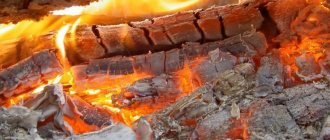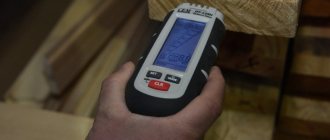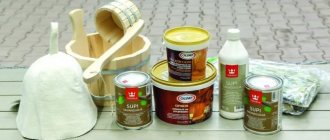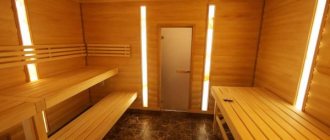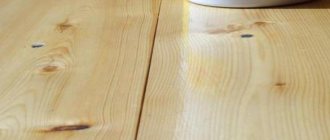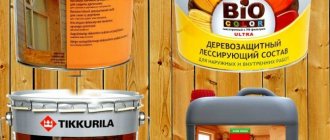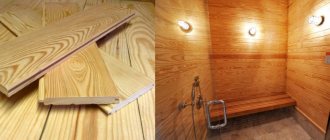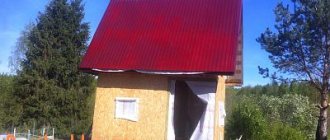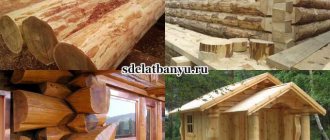Wood as a material will never lose its relevance. But to maintain its beauty and durability, the surface must be periodically subjected to protective treatment.
In outdoor conditions, impregnation for outdoor use is used for this purpose. Thanks to it, the tree becomes resistant to bad weather, insects, and fire.
The main thing is to choose the impregnation that suits your design and is suitable for its purpose.
Why impregnate wood?
The material is popular in construction due to the following advantages:
- environmental friendliness;
- hygroscopicity;
- heat capacity;
- sound insulation;
- aesthetics (even without additional finishing);
- ease of processing and installation;
- affordable price.
However, a wooden structure that is constantly located on the street is destroyed over time under the influence of:
- ultraviolet rays;
- high humidity;
- fungus, mold;
- insects, bark beetles;
- precipitation;
- dust, dirt;
- sudden changes in temperature;
- damage;
- fire.
To prevent spoilage, an impregnation was developed.
It is needed to extend the service life of the material by forming a protective layer on the surface or penetrating deep into the structure.
The drugs are produced in a narrowly targeted manner, when some resist moisture, others – fungus (antiseptics), others – fire (fire retardants), there are decorative ones and more. Complex action impregnations are also available. They are more expensive, but more effective.
It is recommended to work with the product at a temperature of +10 degrees. It will absorb evenly and dry quickly.
In addition, impregnation can be an excellent base for painting. The paint applies well, giving the wood the desired color.
What you need to know about wood species when choosing impregnation
Depending on the type, trees have different degrees of resistance to biodestruction:
- The weakest. This includes linden, alder, and aspen.
- Weak resistance. Solid elm, maple, birch and beech sapwood.
- Medium resistant. These include fir, larch, and spruce.
- Sustainable. Ash, pine, solid oak.
Based on absorbency, rocks are divided into 3 categories:
- Difficult to impregnate. Ash, solid oak and beech, spruce.
- Average. Linden, alder, aspen, solid pine.
- Lungs. Beech, birch, pine sapwood.
It is important to note that when choosing raw materials for construction outside, the key factor remains the resistance of the rock to destruction, so you need to choose the most resistant ones.
Classification of impregnations for external use by purpose
According to this parameter, funds are divided into several types. Let's look at the features of each of them in more detail.
Anti-darkening
A change in the color coating of raw materials is caused by infection with a fungus. This most often happens when wood is stored outdoors for a long time or in constant contact with the ground.
It is important to understand that budget protective impregnations have a limited service life - from 3 to 6 months. More expensive formulations continue to operate after 1–2 years.
The drug must be difficult to wash out or cannot be washed out with water. A striking example is the domestic impregnation brand “Senezh”.
Material already infected with fungus must first be bleached, that is, the cause of infection - fungus or mold - must be eliminated.
For treatment in outdoor conditions, it is allowed to use products containing chlorine. But a significant disadvantage of such compositions is that the impregnation not only burns out harmful microorganisms, but also destroys the wood structure.
Preparations with active oxygen have proven to be much more effective. They destroy fungus without harming the material and do not emit harmful substances.
From moisture and rotting
These are solutions with water-repellent properties. Penetrate deep into the structure. Prevents deformation and rotting of raw materials under the influence of moisture.
Their advantage is that after applying the composition the wood continues to breathe.
The service life of the protective layer is 1-3 years. After its expiration, it is recommended to recoat the material.
High quality impregnation will prevent the material from cracking as it dries. This is especially necessary on the end parts of log houses.
In addition, look for the presence of ultraviolet filters in the composition. Their absence will lead to a reduction in the effect of the product, and the treated surface will begin to darken.
For load-bearing structures
These include:
- rafter systems;
- beams, partitions;
- ceilings;
- walls;
- base;
- basements.
Photo: treatment of the rafter system with a spray bottle.
To reliably protect such elements, the preparation must have the following properties:
- antiseptic;
- fungicidal;
- do not wash off with water;
- increase fire resistance.
They are often colorless, water-based liquids.
The disadvantage of inexpensive impregnations is that they paint the surface a greenish tint. Expensive preparations do not change the shade of wood.
When using indoors, it is important to pay attention to the composition so that it does not contain toxic substances.
Decorative
Compared to others, the purpose of these stains is to add beauty to structures and products. With their help, it will be possible to perform high-quality imitation of noble breeds.
Most acrylic-based products are environmentally friendly. They make the surface elastic, waterproof, add shine, protect the surface from ultraviolet rays, and at the same time act as an antiseptic. They have a wide range of colors.
Frost-resistant
It is recommended to purchase for external wood processing in the northern regions of the country. Withstands air temperatures down to –40 degrees.
Can be applied in the cold without loss of working properties. They tolerate repeated freezing and thawing normally.
Sun protection
They also act as antiseptics. They contain a filter against ultraviolet rays, which serves as reliable protection for the tree. Bright colors do not fade in the sun or fade over time. The surface does not crack due to temperature changes.
Article: how to build a pergola from wood
Fire retardants
This is the name given to the preparations that make the raw material highly flammable. Prevents combustion in case of fire.
The most effective products are those that combine fire and bioprotection. Penetrate deeply into the structure or form a film. They may change the color of the coating, but not the texture of the wood.
When purchasing fire retardants, check for quality certificates and fire safety reports.
How to protect wood from moisture?
If the moisture content of the material exceeds 15%, the structure of the wood begins to collapse: swell, delaminate, and then shrink. As a result, the products change their shape, cracks and gaps appear. Almost all wooden elements are susceptible to high humidity, with the exception, perhaps, of sisal and rattan, since they come from the tropics.
The experiment showed that water does not penetrate the pores of a block treated with a water-repellent composition, while it is quickly absorbed into unprotected wood
There are special solutions that protect wood from moisture. They are divided into two groups:
- penetrating;
- film-forming.
The first group provides a more reliable barrier against the penetration of liquid into the wood structure. The process of treatment with compounds of the second group must be repeated over time. Let's look at two products that resist high humidity.
Aidol Langzeit-Lasur is a medium-viscosity impregnating composition, excellent for covering house walls, country furniture, balcony and terrace railings, and fences. The azure is so safe that it can be used to cover children's toys and buildings. It has many decorative shades: silver-gray, teak, ebony, dark oak.
If coniferous wood is treated with Aidol Langzeit-Lasur, it must first be primed. This rule also applies to products damaged by fungus or mold.
Belinka Interier Sauna contains acrylic resins, water and additives. This is a colorless glaze, ideal for processing wood in baths or saunas. Two layers of the solution are applied with a roller, brush or spray.
Belinka Interier Sauna does not mask the natural texture of wood, but only makes it more silky and shiny. A 2.5 liter jar of azure costs 950-1000 rubles
Famous manufacturers
Below is a list of manufacturing companies whose products are in greatest demand.
Belinka
Country of origin: Slovenia.
Engaged in the production of impregnations for the protection and decoration of wood. This:
- transparent antiseptics;
- penetrating primers;
- azure multilayer impregnation with the addition of wax;
- azure decorative impregnations;
- paints.
Belinka has official representative offices throughout Russia.
Aquatex
A Russian company that produces several types of combined impregnation compositions:
- “Aquatex Extra” - based on wax, oil;
- “Aquatex primer antiseptic” is a non-washable antiseptic;
- "Aquatex" - decorative with bioprotection and others.
Each contains an ultraviolet filter.
Aquatex does not produce products with biopyrene protection.
Tikkurila
The Finnish concern produces many series of paint and varnish products. Products with antiseptic protection, against insects, ultraviolet radiation. They have an environmentally friendly composition. Some antiseptics can be tinted.
Senezh
Russian trademark.
Specialization - production of impregnations for processing wood and decking boards.
The list of products includes:
- biopyrenes;
- preservative solutions;
- antiseptics;
- decorative;
- protective compounds.
There are tinted solutions. The price is affordable.
NEOMID
Russian manufacturing company.
The products are considered one of the best on our market for protecting wood and decking boards from fire and moisture.
On average, antiseptic protection lasts 10 years, and against fire – 7 years.
To control the quality of processing, a tinting pigment is included.
Can be used in residential buildings, bathhouses, gazebos, summer kitchens.
Sequence of application of protective agents
To get a long-lasting result, the protective composition should be applied following the recommended sequence:
- treatment with an antiseptic at the stage of procurement and transportation, upon completion of the assembly of furniture fittings and other structures made of lumber;
- fire retardant (if required);
- moisture repellent;
- paint and varnish composition with UV protection on all external areas;
- acrylic sealant.
Wooden raw materials can be processed using several technologies. The building materials market offers a wide range of different compositions - on organic and chemical bases. To properly process wood, you should carefully select a protective agent and be careful when working with materials.
Tips for choosing
When purchasing, we recommend paying attention to the following points:
- Purpose and place of use. Indoors, it is worth taking environmentally friendly water-based formulations with natural oils. They are produced in the form of a concentrate. There are no special restrictions for outdoor work.
- Availability of quality certificates. Without them, the likelihood of purchasing an effective product is minimal.
- Determine the reason for processing. There are narrowly targeted impregnations on sale that protect only from moisture, insects or fire. The optimal purchase would be a complex drug that combines several properties at once.
- If you want your product to look beautiful, take time to choose the color. Check to see if the product can be tinted.
- Take the drug with a reserve, since concentrates from different batches may differ in tone.
- You should not buy impregnation in the markets. The conditions for storing and transporting goods there are practically not observed. There is a high risk of purchasing a fake.
- Study the instructions for use, namely the service life of the coating. Most products retain their properties for no more than 3-5 years. Inflated figures are a marketing ploy.
- Don't forget about application methods. There are impregnations that are used only by soaking the wood.
- Don't forget to wear a respirator while working.
For outdoor use, it is recommended to use universal, complex action products that simultaneously resist bad weather, insects and fire.
When treating a house made of timber from the outside
The first treatment of wooden houses is carried out before construction.
This is usually done by immersing the logs in a bath of antiseptic solution. But, as a rule, lumber undergoes primary processing under production conditions. If construction is not planned immediately after transportation, it is necessary to ensure proper storage of the timber. Lumber should be stored in a well-ventilated and dry room or under a canopy, in a place where the timber does not come into contact with the ground.
The second treatment of a timber house is carried out within a few days after completion of construction. It is necessary to use water-soluble compounds that do not interfere with the natural shrinkage that occurs in the wood. The air temperature during processing should be at least 5-7 degrees Celsius. If a log house is erected in winter, when all natural processes freeze (including the activity of microorganisms and insects), processing can be postponed until spring.
After the completion of the shrinkage processes, the third treatment of the house frame is carried out. The exact time depends on the type of lumber and the moisture content of the wood. Processing of imitation timber and laminated timber, materials that have undergone chamber drying, can be carried out immediately after construction. Treatment of a house made of profiled timber can be carried out no earlier than in a year and a half, when the moisture content of the lumber reaches 20%.
